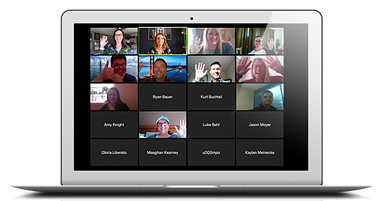Our 2025 Sustainability Report is here! Dive in.
Adjusting to the Challenges of the New Work-from-Home Economy
June 28, 2021 •Franklin Energy

At the peak of the pandemic, an incredible 42 percent of the labor force began working from home full-time, myself included. There is a lot of advice out there on how to excel in this environment, yet more than a year later, according to leading global analytics firm Gallup, employee burnout is a rising concern in our new work-from-home economy. And while a year ago we envisioned a remote workforce to be a temporary solution, it has become clear that working from home is here to stay, with employers seeing benefits in the shift—from cost savings to improved employee retention.
At Franklin Energy and AM Conservation Group, we had to find positive opportunities amidst the pandemic, or our business would have failed. One of the opportunities we saw from the get-go was providing more flexibility in the workplace. A remote work environment results in decreased travel time, less risk to our employees, reduced emissions and energy usage as well as cost savings due to office closures, and for some, an improved work-life balance. As we look forward to coming out the other side of the pandemic, our goal is to take the silver linings we have learned and keep them alive in our refreshed work procedures. The challenge is providing equality and ensuring employees remain motivated, preventing workplace burnout.
 My personal remote-work journey began by taking much of my office and file cabinets home and setting up shop at the dining room table. Working in Human Resources, I thought I was more than prepared for this transition, but I learned early on that our team had to make changes for long-term success. Within the last year of working from home, I have moved from my dining room to a dedicated office space. The file cabinets are gone, as the documents are now scanned and stored electronically. A new work surface and adjustable standup riser allow me to alternate between sitting and standing throughout the workday. With remote work best practices in place, I am now prepared to work from home indefinitely. (It only took me a year to get to this point.)
My personal remote-work journey began by taking much of my office and file cabinets home and setting up shop at the dining room table. Working in Human Resources, I thought I was more than prepared for this transition, but I learned early on that our team had to make changes for long-term success. Within the last year of working from home, I have moved from my dining room to a dedicated office space. The file cabinets are gone, as the documents are now scanned and stored electronically. A new work surface and adjustable standup riser allow me to alternate between sitting and standing throughout the workday. With remote work best practices in place, I am now prepared to work from home indefinitely. (It only took me a year to get to this point.)
Through a combination of online research, learning from others, and trial-and-error, here are some of my solutions to challenges associated with the new work-from-home economy.
Establish Equality
While it has proven to be beneficial for many employers and employees across the country, remote work can quickly shine a spotlight on inequality. Not everyone can work from home efficiently. Many Americans lack the facilities, sufficient internet capacity, and resources to make telecommuting successful. For this reason, it’s imperative that your organization relies on flexibility in the workplace, acknowledging that there’s no one-size-fits all approach.
For those employees who can work from home effectively, it’s vital to empower them by allowing and encouraging the flexibility of choice, and it may also be helpful to provide a stipend for internet access. For those employees who are not able to work from home, whether due to job function or resource constraints, an office environment should be made available. Catering to all employees’ needs and providing viable options can ultimately decrease the number of offices (and size of office space) needed, while still growing the organization and meeting employees’ needs.
Set Goals
Personally, I realized early in my work-from-home adjustment that I needed self-motivation to stay focused at work. One of the most effective ways to motivate both an individual and a team is to set daily, weekly, and monthly goals. Tracking these goals via a universally accessible project-tracking software is a tangible way to visualize progress and monitor timelines. When setting goals, it’s important to include a variety of both small and achievable goals, as well as aggressive and challenging ones. This enables the team to track success and feel accomplished every day, creating motivation to continue. In addition, team meeting agendas should include a couple minutes to recognize accomplishments.
For my team, this became imperative once we were no longer working in the same office—it allows the team to recognize and celebrate individual success and achievements. Two of the top two causes of workplace burnout are an unmanageable workload and lack of manager support. By setting goals for employees and utilizing a clear process for communicating and celebrating those goals, it allows you to keep track of individual workloads, adjusting projects as necessary, and it provides an open forum for constant support and feedback. Both are critical in today’s work environment.
Relationship Building
 The importance of personal contact with co-workers and understanding how that contact strengthens trust became more apparent to me once we moved to a remote workforce. A solid team meeting agenda should start with both a safety message and some jokes—or at the least, a couple less structured minutes to catch up and connect personally. With a remote workforce, it’s important to adapt a more communicative meeting structure, opening discussion beyond just work tasks. In an environment of fast-paced deadlines and high expectations, getting in a laugh or two and just checking in with one another provides an opportunity to take a break from the stress. It is also important to encourage individual teams to incorporate team-building exercises into the workload, like a quarterly team trivia event with prizes or a team-building breakout room.
The importance of personal contact with co-workers and understanding how that contact strengthens trust became more apparent to me once we moved to a remote workforce. A solid team meeting agenda should start with both a safety message and some jokes—or at the least, a couple less structured minutes to catch up and connect personally. With a remote workforce, it’s important to adapt a more communicative meeting structure, opening discussion beyond just work tasks. In an environment of fast-paced deadlines and high expectations, getting in a laugh or two and just checking in with one another provides an opportunity to take a break from the stress. It is also important to encourage individual teams to incorporate team-building exercises into the workload, like a quarterly team trivia event with prizes or a team-building breakout room.
Franklin Energy and AM Conservation Group have even established a book club amongst employees to encourage personal contact and growth. Lastly, keep things fun. We recognize and celebrate unofficial (and silly) national holidays. It is true that every day of the year has at least one special thing to assigned to it. Some of our favorites have been Tortilla Chip Day (2/24), Unicorn Day (4/9), and Answer the Phone like Buddy the Elf Day (12/18). To find more, do a quick Google search of national today or national holidays. Discussing how to celebrate these quirky events allows for personal expression and bonding moments. Some of these ideas are priceless.
Encourage Physical Health
Exercise has long been touted as an effective tool to be healthier and live longer. But recently, studies conducted by the National Institute of Health (NIH) have indicated that even mild exercise, like a 30-minute walk outside, helps prevent the physical, emotional, and behavioral toll that burnout inflicts on our careers. For the sake of employees’ physical and mental health, encourage walking meetings when possible, provide online health and wellness resources, and hold activity-based competitions (like a challenge to get the highest number of steps, for example).
Be Flexible
One of the biggest changes for a largely work-from-home workforce is allowing more scheduling flexibility. Rather than being focused on a typical 8-to-5 workday, it now makes more sense to encourage flexibility in work hours. For my team, this meant a shift in start and end times to allow for family obligations. Employees should be given the flexibility to take care of personal appointments as needed, and take frequent breaks throughout the day now that commuting time to and from work are missing. Giving employees flexibility in work hours and the ability to create a work/life balance throughout the day has been proven to result in more productivity, more company-wide success, and higher employee retention.
Like many employers, our organization is still learning how to best fit the needs of a healthy and happy workforce. And personally, I am still learning and adjusting to my new work environment. For all of you that find yourselves on this journey, I recommend defining what you need to be successful and then taking the necessary steps to get there. And remember to celebrate the small victories along the way.
To learn more about Franklin Energy, who we are, what we do, and how you could fit into our picture, search for open positions here.

